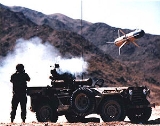
BGM-71 TOW
Overview
Initially developed by Hughes Aircraft
Hughes Aircraft
Hughes Aircraft Company was a major American aerospace and defense contractor founded in 1932 by Howard Hughes in Culver City, California as a division of Hughes Tool Company...
between 1963 and 1968, the XBGM-71A was designed for both ground and heli-borne applications.
Unanswered Questions

